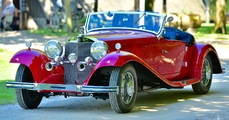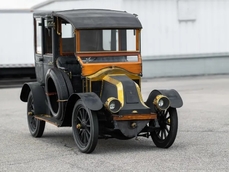Mercedes-Benz 500K Cabriolet A 1935
General description :
1935 Mercedes-Benz 500K Cabriolet AAuthentic inside and out, this 500K boasts of matching numbers and is perhaps one of the finest examples of the 11 remaining Cabriolet As. One of the most desirable of the pre-war Mercedes-Benz body styles, this 500K Cabriolet A represents the very definition of luxury, style and elegance. When Mercedes-Benz introduced its 500K at the Berlin Motor Show in 1934 it was very much charting the future of automobiles. Besides the Kompressor helping to produce some 160 hp, the car would also incorporate external exhausts and a frame that sported fully independent suspension. But Mercedes-Benz also initiated something else with its 'Sindelfingen' moniker. Throughout much of the first half of the 20th century many of the exclusive chassis offered to the public would come with custom-built coach bodies built by outside coachbuilders. Sindelfingen would certainly give the appearance of being an outside coachbuilder but was, in fact, Mercedes' own in-house coachbuilding element. This would, in many ways, help to foster car companies with their own in-house design firms and builders and would place a much greater emphasis within the factory itself to design and build its own special bodies. Sindelfingen would work because it offered a rather extensive catalog of potential body styles for each of its more select models. And, amongst the coachbodies made available for the 500K chassis, one of the more privileged would be the Cabriolet A designed and built by Sindelfingen. Amongst the total of 342 units that would be produced over the course of two years just 33 examples would be fitted with Cabriolet A body-styling.One of those 33 would be chassis 105379. Baron Silfverschiold of Gasevadholm, Sweden would be immediately smitten by the 500K and would place an order for his own in November of 1934. The Baron would specify his 500K to be complete with left-hand-drive, gray paint and a blood-red pigskin leather interior. The car would be finally completed toward the end of April 1935 and would be thereafter delivered to the Baron who would then move and have the car re-registered to his estate, the Castle Koberg in Vastergotland. The 500K Cabriolet A had certainly come home. 105379 would remain with the Baron throughout World War II but would eventually be parked in 1948 when it suffered a tire puncture. While a seemingly straight-forward issue to rectify, the rear wheel nut would be incorrectly threaded and would lead to the car being unused for another couple of years. Then, in September of 1950, Charles-Emile von Oelrich would purchase the car from the Baron and would have the car repaired. Being restored to use, Herr Von Oelrich would immediately take the car on several long-distance outings. Throughout the 1950s, the Cabriolet A would change hands a number of times and would even be owned a short period of time by the music director Birger Ludvigsson. Allan Karlsson would then come to own the car and would remark it's only flaw was the fact that it attracted a large crowd everywhere it went. Gosta Westerberg would come to own the car and would be determined to have it restored. The restoration work would begin in 1962 and would be completed by July of 1963. Soon thereafter the car would again change hands. This time, well-known collector Sven Harnstrom would come to own the car and would enter it in a number of various club meetings over the course of his nearly decade long ownership. When the car was sold to Svante Rosen, the car would continue to enter various collector car events. All throughout this time the 500K would remain in Sweden. However, in 1983 would leave its adopted homeland and would come to be part of a collection in West Germany. In the late 1980s, at the owner's request, Rolf Bunte would restore the Cabriolet A. Bunte would work tirelessly not just to restore the car, but to make sure everything functioned as intended and factory correct. This effort would end up setting a benchmark for the future. Such a beautifully-restored car would not be easy to part with. Therefore, it wouldn't be until 2004 when the car would be sold again, this time to a resident of the Netherlands. Remaining a part of a very private collection, the 500K remained as if completely original. Because of the work of the restoration, and the regular maintenance and upkeep, recent work done on the car would consist of just a mechanical tuning and touch-ups here and there to restore it to near brand-new condition.A very desirable body style, one of just 33 examples built on the 500K chassisFascinating, well-known ownership historyHandsome older restoration, still in attractive conditionExcellent colors, well-suited to this coachworkClassic Car Club of America (CCCA) Full ClassicPrice: $2,450,000
1935 Mercedes-Benz 500K Cabriolet A is listed for sale on ClassicDigest in New York by Gullwing Motor Cars for $2450000.
Car Facts
Car type : Car Make : Mercedes-Benz Model : 500K Model Version : Cabriolet A Engine size : 0.0 Model Year : 1935 Location : Astoria Vehicle Registration : Undefined
2450000 $
People who viewed this Mercedes-Benz 500K also viewed similar Mercedes-Benz listed at ClassicDigest
Other cars listed for sale by this dealer
About Mercedes-Benz
In the annals of automotive history, the journey of Mercedes-Benz is a tale that unfolds with the ingenuity of its founding pioneers. In the year 1886, Karl Benz crafted the Benz Patent Motorwagen, a creation that would go down in history as the world's inaugural automobile. Unbeknownst to him, this moment marked the genesis of what would evolve into the most illustrious premium car manufacturer globally. The financial underpinning of this pioneering venture, interestingly, was provided by Karl Benz's wife, Bertha Benz, demonstrating a remarkable partnership that would set the tone for Mercedes-Benz's legacy.A parallel narrative emerged not far away, as Daimler-Motoren-Gesellschaft, founded by Gottlieb Daimler and Wilhelm Maybach, entered the scene. In 1901, they unveiled their automobile under the now-famous moniker "Mercedes," meaning "godsend" in Spanish. This name was bestowed upon the car at the behest of Emil Jellinek's daughter, the distributor for Daimler-Motoren-Gesellschaft. The wheels of innovation were set in motion.
Fast forward to 1926, a pivotal year that witnessed the merger of Daimler with Benz & Cie., culminating in the birth of Daimler-Benz. The amalgamation saw the adoption of "Mercedes-Benz" as the distinguished trademark for their automobiles, fusing the legacies of two visionary entities into one.
Contrary to perceptions of conservatism, the trajectory of Daimler-Benz unfolds as a chronicle of industry firsts. From the introduction of the honeycomb radiator to the float carburetor, and the pioneering implementation of four-wheel brakes in 1924, Daimler-Benz consistently pushed the boundaries of automotive innovation. The diesel-powered Mercedes-Benz 260 D in 1936 marked the inception of diesel engines in passenger cars. The iconic Mercedes-Benz 300SL Gullwing made history as the first car with direct fuel injection, albeit the Gutbrod's tiny 2-stroke engine can claim precedence.
Safety innovations became a hallmark, with Béla Barényi's patented safety cell design in the "Ponton"-models in 1951, featuring front and rear crumple zones. The W116 450SEL 6.9 saw the introduction of the Anti-Lock Brake system (ABS), another pioneering safety feature. From the first production airbags and beyond, the legacy of "firsts" continued to be etched into the fabric of Daimler-Benz.
Over its centennial journey, Mercedes-Benz has not merely produced cars but has sculpted automotive icons. The SSKL, 710 SSK Trossi Roadster, 770K Grosser, 540K Spezial Roadster, 300SL Gullwing, w100 600 Pullman, w111 280SE 3.5 Flachkühler, w113 230SL Pagoda, w109 300 SEL 6.3, and w201 2.3-16 Cosworth stand testament to the brand's commitment to engineering excellence.
The roaring Silver Arrows, or "Silberpfeile," including the W 25, W 125, W154, W165, and W196, created a legacy of dominance on the racetrack. These machines were not merely cars; they were expressions of precision, speed, and an indomitable spirit that left their competitors in the dust.
As Mercedes-Benz marches into the future, it does so not just as an automaker but as a custodian of a legacy, a torchbearer of innovation, and a beacon of automotive excellence. The road ahead is sure to witness the continued fusion of cutting-edge technology, timeless design, and an unwavering commitment to setting new standards in the world of automobiles.
One luminary figure who left an indelible mark was Béla Barényi, often heralded as the "father of passive safety" for his pioneering work in safety engineering. His patented safety cell design, featuring front and rear crumple zones, became a hallmark of Mercedes-Benz's commitment to occupant safety, setting new standards that reverberated throughout the automotive world.
Moving through the chronicles, the collaborative genius of Wilhelm Maybach, alongside Gottlieb Daimler, laid the foundation for Daimler-Motoren-Gesellschaft. Their innovations not only birthed the first Mercedes but established a culture of relentless pursuit of technological excellence that remains integral to Mercedes-Benz's DNA.
In the post-merger era of 1926, Ferdinand Porsche emerged as a prominent figure within Mercedes-Benz. His work on the Mercedes-Benz S-Type, a supercharged race car, garnered acclaim and set the stage for a legacy that extended far beyond the marque. Porsche's impact would later extend to his eponymous company, but his influence at Mercedes-Benz during those formative years was pivotal.
As the 20th century progressed, the legendary Rudolf Uhlenhaut emerged as a key figure. Uhlenhaut, an accomplished engineer and the driving force behind the iconic Silver Arrows, played a crucial role in Mercedes-Benz's dominance in motorsports. His engineering prowess and attention to detail were instrumental in creating some of the most formidable racing cars of the era.
In the latter half of the century, figures like Bruno Sacco, the head of design at Mercedes-Benz from 1975 to 1999, left an indelible imprint on the brand's aesthetic identity. Sacco's design philosophy, characterized by clean lines and timeless elegance, shaped iconic models like the W126 S-Class and the W201 190E, solidifying Mercedes-Benz's reputation for luxury and sophistication.
The narrative would be incomplete without acknowledging the contributions of engineers like Hans Scherenberg, whose leadership in the 1970s ushered in a new era of technological innovation at Mercedes-Benz. Scherenberg's tenure saw the development of groundbreaking technologies, including the Anti-Lock Brake system (ABS) and the introduction of airbags in production cars.


















